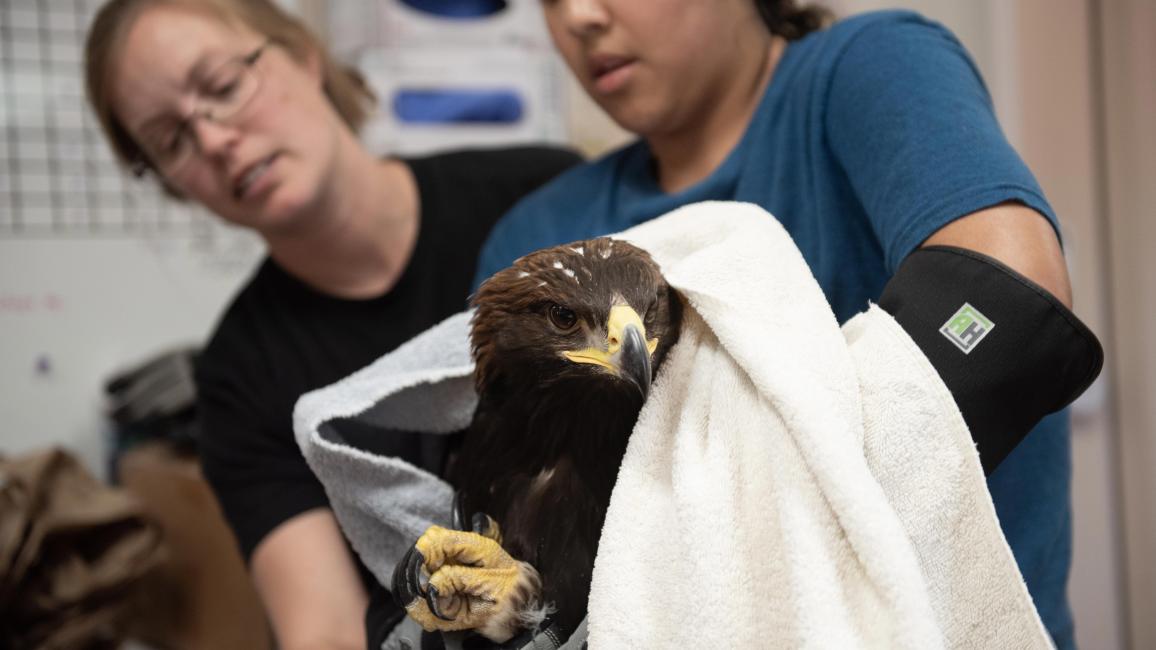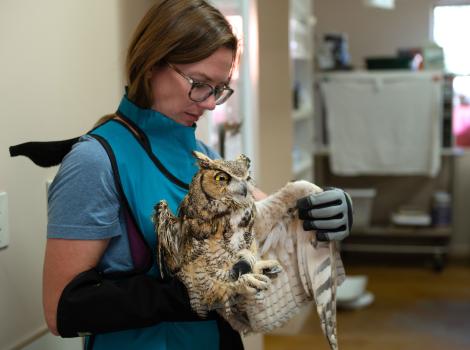Eagle displaced by wildfire on road back to the skies

Wildfires are devastating, often displacing wild creatures from their homes and families. This was the case when firefighters battling a wildfire first discovered a juvenile golden eagle sitting with his head hanging down beside a road leading toward the fire, suggesting that his predicament was fire related. Seeing that he needed help — and fast — they brought the large raptor to Wild Friends, Best Friends’ state- and federally licensed wildlife rehab center.

A delicate balance
“He didn't have any burns or damage from smoke inhalation, which is what I was concerned about when they first told me they were bringing him in,” says Lauren Ross, Wild Friends caregiver and licensed rehabilitation subpermittee. “He was just really dehydrated and emaciated. He may have been separated from his family group or was struggling to learn how to hunt on his own, and the fire compounded those issues.”
Wild Friends staff quickly began stabilizing the massive bird, carefully balancing the need to provide vital nutrients without overwhelming his system. Dehydrated and emaciated birds are prone to organ failure, which can be exacerbated if food or fluids are introduced too rapidly. The rehab team started the young raptor on fluids the first day, then slowly introduced food through tube-feeding the next day.

Defying the odds
Staff were on pins and needles, as positive outcomes in cases like this are, unfortunately, not common. But this young raptor was a fighter, showing improvement with each passing day. Staff worked round the clock, and after a week of daily fluids, tube-feeding, and antibiotics, the light crept back into his amber eyes. And he started eating on his own at last. Elation and whoops of joy filled the air as the team celebrated his progress. “It was just the happiest day for all of us,” recalls Lauren. “It was so rewarding.”
That meant he was well on his way toward a successful recovery. It also meant they no longer had to tube-feed an enormous raptor with razor-sharp talons, a piercing beak, and a six-foot wingspan (phew). Now he was ready for the next step in recovery: learning to fly again.

Slow and steady
Wild Friends staff relocated the eagle to a spacious flight building, offering ample room and a variety of perches for him to start the long process of rebuilding his massive flight muscles. His progress remains slow but steady.
“He's still uncoordinated and can't fly yet, but he's trying,” says Lauren. She notes that golden eagles generally take longer to rebuild their flight muscles than other species due to their large size, powerful musculature, and the specific demands of their flight style. So this majestic bird will be recuperating at the Sanctuary for a while, safe and sound in capable hands.

A rewarding rescue
While rehabilitating wild creatures is often a roller coaster of emotion, it’s also an opportunity to witness their resilience and contribute to their journey back to freedom, something Lauren finds deeply fulfilling and inspiring.
“It's always exciting to rehab an eagle and get them back out there,” says Lauren. “They're such a cool species to work with because they're so big, which makes rehabbing both challenging and rewarding.”
The wildfires have been put out, and this golden-feathered fellow will soon feel the wind beneath his wings once more when he’s strong enough to return to the skies where he belongs.
Let's make every shelter and every community no-kill in 2025
Our goal at Best Friends is to support all animal shelters in the U.S. in reaching no-kill in 2025. No-kill means saving every dog and cat in a shelter who can be saved, accounting for community safety and good quality of life for pets.
Shelter staff can’t do it alone. Saving animals in shelters is everyone’s responsibility, and it takes support and participation from the community. No-kill is possible when we work together thoughtfully, honestly, and collaboratively.






